Fed Earns Money, TARP Loses It
The Federal Reserve announced, this morning, that it will transfer $46.1 billion in FY2009 profits over to the Treasury, higher than the $31.7 billion in 2008 profits (Thanks to Donald Marron for pointing this out). The Fed reported that the increase in profits was due largely to earnings on additional securities holdings.
Total gross earnings for the Fed reached $58.6 billion for 2009. Including the costs for operating the 12 Reserve Banks, interest and dividends paid to member banks, and Board expenditures, profits came to $46.1 billion.
Profits accrued from security purchases ranging from U.S. Treasury securities, GSE debt securities, federal agency mortgage-backed securities, earnings from limited liability corporations (AIG collateralized debt, Bear Sterns funding, AIG MBS’s), and loans to primary dealers, all of which are tracked by CRFB at Stimulus.org.
Although the actions of the Fed are not directly recorded in the federal budget, Federal Reserve Board policy requires all Reserve Banks to transfer profits over to the Treasury. This remittance is generally in the range of $20 to $30 billion each year. But given the extraordinary and unprecedented action taken by the Fed in more than doubling the size of its balance sheet to help shore up financial markets and the economy (see CRFB’s paper The Extraordinary Actions Taken by the Fed), the Fed has accrued larger than normal profits.
Yet, the Fed has added large amounts of risk to its portfolio of securities. A year ago, in fact, the CBO has estimated that the Fed’s earnings will be lower by approximately $90 billion over the next ten years as losses on some of the more risky assets materialize. So while taxpayers are certainly benefiting from high profits today, there is no guarantee they will last.
In related news, the Treasury reported yesterday that in FY 2009 the net cost of TARP was $68.5 billion, down from original estimates of $178 billion. The Capital Purchase Program generated a $15 billion profit for the Treasury, while support for AIG and the auto industry cost the government $30.4 billion each.
Check back regularly to Stimulus.org, where CRFB will continue to track all TARP and Fed balance sheet developments.


